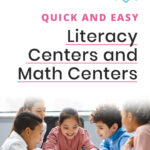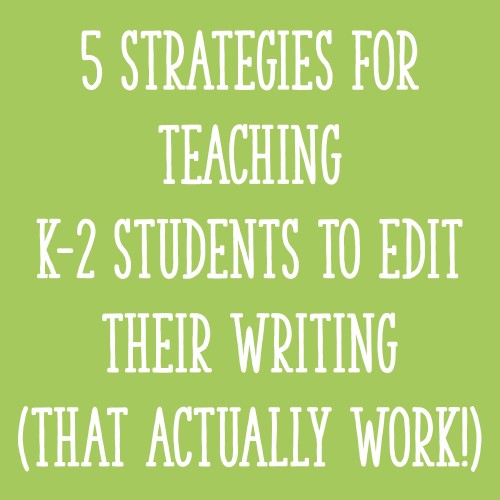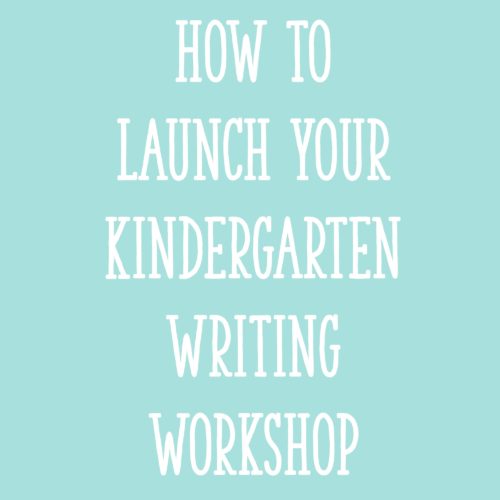Do you have enough time in your daily literacy block? I’m guessing that the answer is no.
A while back, I wrote posts about scheduling your literacy block in Kindergarten, first grade, and second grade. I included the following as potential components of a literacy block:
- Shared Reading
- Guided Reading / Independent Literacy Activities or Centers
- Readaloud
- Reading Workshop Minilesson
- Independent Reading
- Writing Workshop Minilesson
- Independent Writing
- Phonics, Word Study, Phonemic Awareness
The reality is, that’s a LOT of stuff!
I have taught in schools where I had plenty of time for all of that. But I’ve also been in situations where there just wasn’t enough time to fit everything in.
So what did I do in those less-than-ideal situations? In this post, I’m sharing 5 things I’ve done to help beat the time crunch!

Photo Credit: wavebreakmedia, Shutterstock
#1: I shifted my mindset.
Mindset matters, and it matters a lot!
As much as I would love for an extra 30 minutes to materialize, or for my students to become SO fast at transitioning that we have time for a whole extra lesson….neither of those things is likely to happen.
And anyway, I’ve come to believe that less is more.
If I only have time for a very quick readaloud and a rushed vocabulary activity, I’ll pick one of those things and really focus on it. My instruction is better when I’m not trying to just “get through” something so we can move on to the next activity.
So instead of asking myself, “How can I fit everything in?”, I try to ask myself, “What activities are most important and could realistically fit into this timeframe?”
Furthermore, I think we have to remember that literacy routines exist for the purpose of helping our students achieve our instructional goals. A routine (i.e. shared reading, independent writing) is not an end within itself.
In her book Comprehension From the Ground Up, Sharon Taberski urges us to think about literacy routines as a menu.
Just like we don’t order EVERYTHING on the menu when we go to a restaurant, we don’t have to power through all of the literacy routines every single day.
Instead, we need to select the routines that best fit our students’ needs and the concepts that we want to teach.
#2: I eliminated some stuff.
Eliminating certain things is, I think, an important part of having a “less is more” mindset.
I think about it like cleaning out my closet – I have to ask myself, “What do I actually wear, and what am I leaving in here just because I think I might want to wear it someday?” (Or my husband asks it…whichever. ;-))
I know it can be really challenging to think about eliminating certain components. Your school might even have a huge list of requirements that you have to follow.
But maybe…
Could you see one less reading group? It’s not necessary to see all your kids every day – that just leads to rushed instruction.
Could you pick just ONE most important teaching point for shared reading? And really stick to it – while reading only a third or half of the book?
Could you get rid of one time-consuming transition? Maybe go directly from centers to word work, so the kids can easily transition into a word study center or activity?
Could you cut the length of your morning message in half?
Could you change up your centers less often, so you spend less time explaining procedures every day/week?
Could you eliminate time consuming cutting/pasting from a certain activity or routine – by asking volunteers to prepare materials instead? (I definitely think kids need to do “that stuff” for their overall development as little people, but we all know there are certain activities where the cutting or gluing takes up a little too much time!)
Could you eliminate a whole-class bathroom break – by just allowing your kids to go when they really need to go? (Use your judgment here…I know some schools require bathroom breaks. And I know that sometimes there’s a safety issue if the bathroom is far away. But if you can do this, I’d encourage you to try it!)
Could you speak to your principal about maybe doing a certain instructional routine every other day? (See #3 for more about that.)
This is all just food for thought, of course – I know that individual situations vary widely!
#3: I created an A/B schedule.
A little while ago, I was co-teaching in a half-day Kindergarten classroom. If you’re familiar with half-day Kindergarten, then you know that it makes for a SUPER short day!
When we sat down to create our schedule, we knew that we needed to incorporate a certain dictation writing activity that was required by the district. We also knew that we wanted our students to have opportunities to write freely. And there definitely wasn’t time for both each day!
To solve this problem, we created an A Day / B Day kind of schedule. On A days, we did the dictation writing activity. On B days, we used more of a workshop approach.
To apply this to your own situation, think of two routines that always feel rushed. Consider alternating routines, so that you’re doing one on “A” days and the other on “B” days.
Or if you can’t completely eliminate one routine from your schedule, just change up the amount of time you spend on it. Maybe writing time lasts longer on A days, and word study lasts longer on B days.
#4: I recruited my students to help me save time.
One year, when I was teaching in a 1st/2nd split classroom, a big chunk of the day was reserved for intervention/enrichment instruction. That was fine, but it left limited time for regular instruction!
Anyway, there really was no time to waste that year. So I just sat down with my students and explained the situation to them.
We set goals for how long it would take us to clean up and transition between activities. If we met certain goals, then they got a short break.
Yes, adding a break was just one more thing to fit in – but it motivated them to transition more quickly and saved us time overall. Plus, they were refreshed and ready to learn after having had a break!
When I taught Kindergarten, enticing them to clean up and come to the rug quickly helped a lot. I’d start showing the kids on the rug something interesting, like a learning toy or something on the iPad. The other kids would want to see what it was, so they’d hurry up and join us.
One other point – time spent teaching or re-teaching procedures is never time wasted. Even if we have to completely disrupt our routine, I will do so in order to re-teach procedures. This makes everything go more quickly in the long run!
#5: I integrated literacy with the content areas.
I don’t even like to call it “integration,” honestly. Learning about math, science, and social studies inherently involves learning literacy skills, too!
But here are a few ideas in that area:
- Choose guided reading texts that are related to your current area of study for math, science, or social studies (ReadWorks.org is a great free resource for this). Read them during guided reading OR do one guided reading rotation during your regular science/social studies time.
- Teach a reading strategy while you’re doing a shared reading / readaloud of a book (or even the textbook!) during math, science, or social studies. While I avoid having tons of objectives for one activity, you really can teach a reading strategy here or there, even when your primary goal is to teach students content area information.
- Have students independently or partner read content area materials during science or social studies. ReadWorks digital is a great resource for these activities. Many of the passages have audio recordings or different leveled passages on the same topic.
Conclusions
It’s easy to become overwhelmed thinking about all that we have to teach in the limited amount of time that we have. But instead of trying to cram everything in, I encourage you to do fewer things, and focus on doing them really well.
Could any of these ideas work in your classroom? Have anything to add? Let me know your thoughts in the comments!
References
Taberski, S. (2011). Comprehension from the ground up: Simplified, sensible instruction for the K-3 reading workshop. Portsmouth, NH: Heinemann.













Very helpful ! Thank you. I need to try the A/b schedule. I teach two groups and only get 90 min to do a lot of things !!! This offers an alternative for teachers . Thanks for sharing this great idea !
You’re welcome, Kristy! Glad it gave you an idea of something to try!! 🙂
Alison
Thank you for this insightful post! This makes so much sense! Sometimes we just get so caught up in the “gotta get everything in” race, when what we really need to is slow down, focus on one main learning objective for the day, and do that one thing really well, whether it’s reading, writing, or word work.
SO very true! This post serve as a reminder to myself, too! 🙂 I’m so glad it was helpful!
Alison
Thank you. I will definitely be utilizing the A/B schedule.
You’re welcome, Tamara! I hope it works out well for you!
Alison
I teach dual language and see my students for half day. Can you post what your schedule looks like? Thank you!